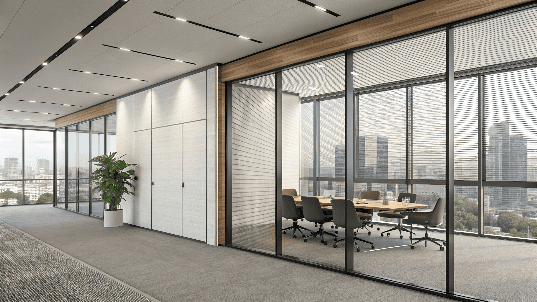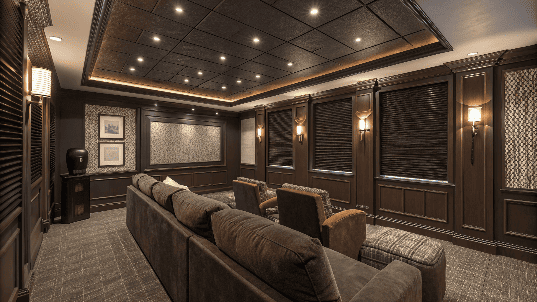Is constant noise from outside interrupting your peace at home or work? Sounds like traffic, neighbors, or even internal echoes can make a space feel chaotic, affecting your focus and comfort.
Cellular shades, often called honeycomb blinds[^1], effectively reduce noise by trapping air within their unique cellular structure. This design creates an insulating barrier that absorbs sound waves, dampening external noise and improving a room's acoustics.

In my work helping global distributors and project contractors, noise reduction is a common need, especially in urban environments. We often seek solutions that offer both functionality and comfort. Cellular shades have proven themselves in this area. Let's delve into how they perform and what to expect when using them for sound control.
Do cellular shades block noise?
Are you wondering if cellular shades can truly bring a sense of quiet to your space? The promise of quieter rooms is often debated.
Yes, cellular shades significantly help to block or reduce noise, particularly due to their honeycomb design which traps sound energy[^2] within their cells, creating a more tranquil indoor environment.

I've seen many homes and commercial spaces transformed by cellular shades, especially when noise is a key concern. Their unique honeycomb design is not just for thermal insulation; it excels at acoustic dampening. The air pockets within the cells absorb sound waves, reducing both noise coming from outside and echoes within the room. For example, certain cellular shades, like Duette® Honeycomb Shades, are advertised to absorb up to 70% of sound energy. While no window treatment can entirely soundproof a room, cellular shades offer a noticeable improvement over untreated windows or lighter window coverings. They are a top choice for sound absorption and are particularly beneficial for spaces like home theaters or bedrooms where quiet is preferred.
What are the best shades for sound reduction?
Are you looking for specific window treatments[^3] that excel at dampening unwanted sounds? Finding the right shade can significantly impact your comfort.
Cellular shades are superior for sound reduction because their honeycomb structure effectively traps and absorbs sound waves. Roman shades, with their heavier fabrics, also provide good sound-absorbing layers.

From my perspective, when noise reduction is a primary goal, not all shades are equal. Cellular shades stand out as the top window coverings for sound absorption. Their unique cellular design creates air pockets that act as a barrier to sound. The material, often a fabric, also contributes to absorbing sound once it passes through the window. Roman shades are another strong contender. Their construction uses thick fabric which adds a sound-absorbing layer, similar to how soundproof curtains work. For maximum effectiveness, combining window treatments, such as layering side panels or drapery over cellular or Roman shades, can provide even greater sound absorption and depth to the window. This layering creates additional mass and air pockets, making it harder for sound to penetrate.
Do noise cancelling shades work?
Are you hoping for a miracle solution that will completely silence your environment? The term "noise canceling" can sometimes create unrealistic expectations for window treatments[^3].
True "noise canceling" involves active technology that shades do not possess. However, specialized noise-reducing shades, like cellular or honeycomb blinds, effectively work by dampening and absorbing sound, significantly reducing its intensity rather than electronically canceling it.

It's important for project buyers and homeowners to understand what "noise canceling" really means in the context of window treatments. Unlike headphones that use active noise cancellation technology, blinds operate on passive principles. They do not actively eliminate sound waves. Instead, they function by either absorbing the sound energy, reflecting it, or blocking its direct path into a room. Cellular shades work particularly well by trapping sound waves within their honeycomb cells, effectively reducing the noise level. While some vendors might speak in terms of "noise cancelling," it is more accurate to describe these products as noise-reducing or sound-absorbing. They will muffle outside noises and reduce reverberation within a room, but they will not create 100% soundproof conditions. The goal is to make the environment quieter and more peaceful, which these shades certainly achieve to a noticeable degree.
What is the difference between cellular shades and honeycomb shades?
Are you confused by the different names for seemingly identical window coverings[^4]? It's a common question in the industry.
There is no difference between cellular shades and honeycomb shades; the terms are interchangeable and refer to the same type of window treatment characterized by its distinctive cellular or honeycomb-like pleated design when viewed from the side.

This is one of those industry quirks that often leads to confusion. As someone deeply involved in sourcing and specifying window treatments, I can confirm that "cellular shades" and "honeycomb shades" are simply different names for the same product. The name derives from their unique construction: when viewed from the side, the fabric folds create individual cells or pockets that resemble a honeycomb structure. These cells are crucial for their insulating properties, which help with both temperature control and sound absorption. Some manufacturers, like Hunter Douglas, specifically use the term "Honeycomb" to denote their product lines (e.g., Duette® Honeycomb Shades), but the underlying design is that of a cellular shade. So, whether a client uses "cellular" or "honeycomb," they are referring to the same energy-efficient and sound-dampening window treatment.
Which is better: single or double cellular shades for noise?
Are you trying to decide how many layers of cells you need for effective noise reduction? The construction directly impacts performance.
Double cellular shades are better for noise reduction than single cellular shades because their two layers of cells provide increased insulation and sound blocking properties by trapping more air and creating a more substantial barrier against sound waves.

When dealing with significant noise, clients often ask if the extra cell layer in double cellular shades makes a real difference. In my experience, and according to product specifications, double cell shades do offer superior noise reduction compared to single cell shades. The principle is simple: more trapped air equals better insulation against both temperature and sound. Single cell shades offer insulating properties, but double cell shades provide increased insulation and noise blocking. This is because the additional layer of cells creates a second barrier that sound waves must penetrate, dissipating more energy in the process. If a project requires a substantial reduction in noise, especially from a busy highway or city environment, investing in double cellular shades[^5] is generally worth the upgrade. They are specifically recommended for areas with high traffic noise or where maximum sound dampening is desired.
Why are cellular shades so expensive?
Are you looking at the price tag for cellular shades and wondering what makes them cost more than other options? Their value comes from unique features.
Cellular shades are more expensive due to their high-quality, specialized fabrics, complex honeycomb construction that provides superior insulation and noise cancellation, and advanced features like cordless or motorized lift systems.

From a project procurement standpoint, the cost of cellular shades reflects their advanced design and functional benefits. Unlike simpler blinds, cellular shades use sophisticated manufacturing processes to create their unique honeycomb structure. This design, material quality, and construction are critical for their top-tier insulation and noise-canceling capabilities, which are often absent or less efficient in ordinary window treatments. Factors like fabric quality (tear-resistant fabrics, waterproof, mildew-resistant) directly impact durability and performance. The precision required in cutting, trimming, and forming the uniform honeycomb shapes also adds to manufacturing costs. Furthermore, features like cordless or motorized operating systems, which offer enhanced safety and convenience, contribute to the price. While they might have a higher initial investment compared to mini blinds or faux wood blinds, their long-term benefits in energy savings and comfort make them a valuable asset, justifying the expense over time.
| Factor | Impact on Cost | Benefit Justification |
|---|---|---|
| Material Quality | Higher cost for specialized, durable fabrics. | Tear-resistant, long-lasting performance. |
| Honeycomb Design | Complex manufacturing process for precise cell formation. | Superior insulation, effective noise absorption. |
| Layer Count | Double or triple cells cost more. | Enhanced thermal and acoustic performance. |
| Operating System | Cordless or motorization adds to the price. | Child safety, convenience, smart home integration. |
| Energy Efficiency | Designed to reduce heat transfer, lowering utility bills. | Long-term energy savings and improved comfort. |
| Noise Cancellation | Built-in acoustic properties for sound reduction. | Quieter living/working spaces. |
Do cellular shades actually insulate sound?
Are you curious about the actual science behind cellular shades' noise-reducing claims? It's all about how they interact with sound energy.
Yes, cellular shades actually insulate sound by trapping air within their distinct honeycomb cells, which acts as a barrier to dampen sound waves and reduce their transmission through windows, thereby improving a room's acoustics.

My understanding of cellular shades confirms their ability to insulate sound effectively. The core of their sound-insulating capability lies in their unique cellular structure. Each cell forms an individual air pocket. When sound waves hit the shade, they are forced to travel through multiple layers of fabric and trapped air. This process causes sound energy to be absorbed and dissipated, rather than directly transmitted through the window. This design can notably reduce external noise, such as traffic or loud neighbors, making the indoor environment significantly quieter. While they do not make a room completely soundproof, they provide a very effective acoustic dampening[^6] effect, distinguishing them from other window treatments that offer less insulation. This characteristic is especially valuable in noisy areas, helping to create more peaceful and productive spaces.
Conclusion
Cellular shades effectively reduce noise by leveraging their unique honeycomb structure to trap and absorb sound. Their ability to insulate both temperature and sound makes them a valuable investment for enhancing comfort and quiet in any space.
Extended FAQ Section
What are the benefits of combining window treatments for noise reduction?
Combining window treatments for noise reduction offers enhanced performance beyond what a single treatment can achieve. Layering, for instance, a cellular shade with heavy drapes or side panels, introduces multiple barriers and air gaps that absorb and block sound waves more effectively. The cellular shade provides the primary sound dampening due to its trapped air pockets, while the drapes add significant mass and soft surfaces to absorb reverberations and block additional noise leakage around the window edges. This multi-layered approach also allows for greater flexibility in controlling light, privacy, and thermal insulation, leading to a more comfortable and energy-efficient environment. For a project buyer, this means a more comprehensive solution for acoustic challenges, resulting in higher occupant satisfaction.
Are cellular shades suitable for all room types when considering noise reduction?
While cellular shades are excellent for noise reduction, they are not ideal for all room types. Their fabric construction and cellular pockets, while great for trapping air and sound, can also trap dust and make them more challenging to clean thoroughly compared to smooth-surface blinds. Therefore, they are not typically recommended for rooms with high humidity, such as bathrooms, laundry rooms, or kitchens, as moisture can lead to mold or damage the fabric over time. However, for bedrooms, living rooms, home offices, or media rooms where quiet and insulation are paramount, cellular shades are highly suitable. I generally advise placing them in spaces where their acoustic and thermal benefits can be maximized, and where cleaning can be managed with routine dusting and gentle care.
How do cellular shades compare to roller shades in terms of noise reduction?
When comparing cellular shades to roller shades for noise reduction, cellular shades are generally superior. Roller shades, consisting of a single piece of fabric, offer some noise reduction by adding a barrier to the window, especially if they are made from thick or blackout materials. However, their flat design does not create the insulating air pockets that cellular shades possess. Cellular shades, with their honeycomb structure, are specifically designed to trap air, which makes them far more effective at absorbing sound waves and dampening noise transmission. For projects where significant sound reduction is a priority, cellular shades will provide a more noticeable difference in quietness compared to standard roller shades, whose primary benefits lie more in light control and a sleek aesthetic.
Ready to Power Your Projects with Smarter Blinds?
Enhance occupant comfort and improve acoustic environments in your next project. Request a personalized quote and detailed specifications for high-performance cellular and honeycomb blinds designed to meet rigorous standards. Our team provides expert guidance to help you select the ideal smart shading solutions for superior noise reduction and energy efficiency.
info@velablinds.com
---
[^1]: Learn about honeycomb blinds and their unique design that helps in sound absorption.
[^2]: Explore how different materials absorb sound energy and improve indoor acoustics.
[^3]: Explore the top window treatments that can help absorb sound and improve comfort.
[^4]: Explore the best window coverings that can significantly absorb sound and enhance peace.
[^5]: Explore how cellular shades can enhance your home's tranquility by effectively reducing noise.
[^6]: Understand the science behind acoustic dampening and its importance in window treatments.Partner with VelaBlinds for Your Next Project
Smart window treatments shouldn't be complicated. After working with 500+ distributors and contractors worldwide, I've streamlined the process to get you quality products, competitive pricing, and reliable support - every time.
Why project professionals choose VelaBlinds:
- ✅ Fast, Accurate Quotes - Detailed specs and pricing within 24 hours
- ✅ Transparent Pricing - No hidden fees, volume discounts clearly outlined
- ✅ Quality Assurance - Direct partnerships with certified OEM manufacturers
- ✅ Project Support - Dedicated account manager from quote to delivery
Start your next project:
📧 Quick Quote: Send your requirements to info@velablinds.com
📱 Direct Contact: WhatsApp +86 137 2012 8317
🌐 Browse Solutions: https://velablinds.com/
📁 Product Resources: Access spec sheets, catalogs & project files
Jimmy Chen, Founder
"I built VelaBlinds to solve the real challenges I faced as a project buyer - long lead times, unclear specs, and unreliable suppliers. Let's discuss how we can power your projects with smarter blinds."
Serving distributors and contractors across North America, Europe, and Australia since 2018.



